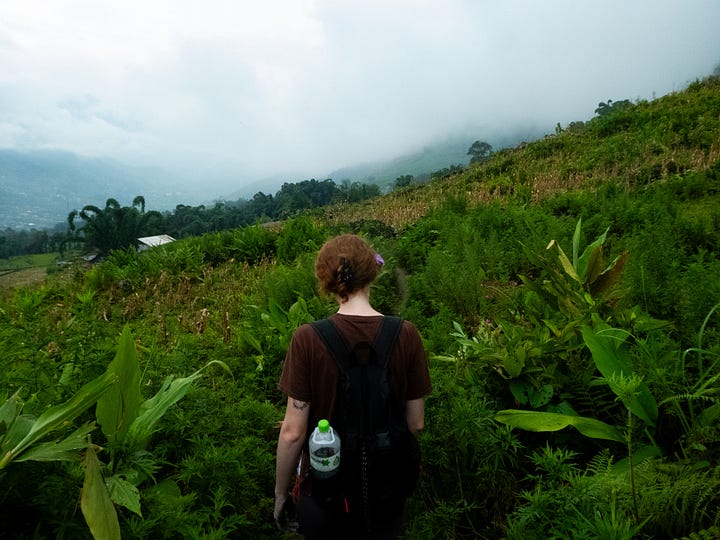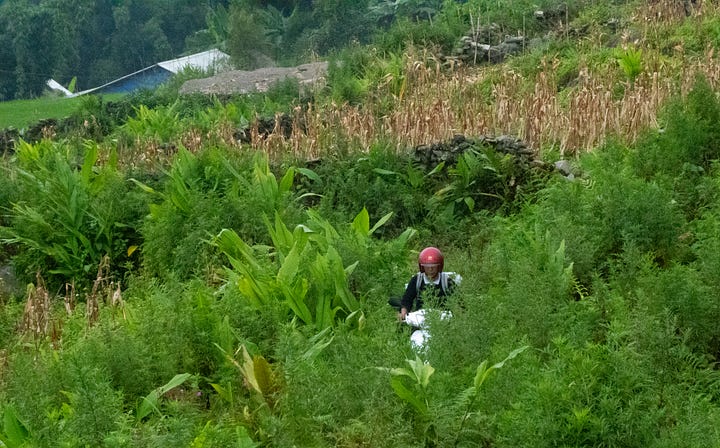Sa Pa: Tradition, trekking and tourism
In Sa Pa we went on an exhilarating trek through terrain and landscapes that encapsulate the beauty of rural Vietnam.
Our guide gave us an insight look into life for the locals and how it’s shaped by both tradition and tourism.
Our guide brought along her friends for the trek as well as her daughter and another girl. We thought that was fun until a few hours in they kept asking us to buy stuff.
It was blisteringly hot at the start of the trek. Our guide was ethnically Black Hmong but wore the traditional clothes of another group because they were ‘colder’. It was still long sleeved and trousered while we were in our shortest shorts and smallest tops.
Despite the heat, we still got soaked passing through a bamboo plantation. Bamboo leaves hold so much water that when we used the trees to steady ourselves it came down fast and hard.
We passed kids reclining up on tree branches just talking. They had their bags, Spider-Man-themed, resting on other branches.


The sunny skies were short lived. Aggressive rain did it's best to ruin the hike but nothing could dampen the views of the farms and fields layered up mountains like the Colosseum’s tiers. Anyway, it's hard to complain while we saunter past farmers up to their necks in it.
The narrow paths meander around small houses and tool sheds. They shoot up and down randomly as if they weren't planned, just dropped in one piece from above.
The women had dark blue hands and showed them proudly, as a testament to the work that discoloured them.
They picked indigo along the path and told us to roll it in our hands. After a while it went green, then blue. Once we had thoroughly smurfed our hands they told us it would take days to come out.
One of the girls made it her mission to make sure I wouldn't fall. It didn't matter how slippery or small a step was, she offered to help me.
I mostly walked with her and the main guide while Kayleigh lumbered behind with the other women.
It seemed like they wanted her to practice her English so I asked all the usual questions you ask kids: What age are you? What do you do for fun? Does this job pay well?
Eventually, after the scam, it was just us and the guide again.
She told us about her life. A multi-hour walk with a stranger is a great way to get to know them. She learned English and speaks it nearly fluently just from talking to tourists her whole life.
She has been married twice and has children with both men. Her new husband is much poorer, and they live in a smaller house, but she is much happier with him. He is six years younger, which is uncommon here, and she told him he should find someone younger. He told her that wasn’t possible, he didn’t want anyone else.
Since they are poor, they don’t always have money at the same time. When he has money, he pays for everything; when she has it, she pays.
Cultural Museum
We learned more about her culture and those of the six ethnic groups in Sa Pa district at the cultural museum.
Hmong is the main ethnicity with 27,324 (51,65%), the Dao 12,189 (23,04%), the Kinh 9472 (17,95), the Tày 2507 (4,745), the Giay 720 (1.36%), the Phu La (Xa Pho) 563 (1,06%).
The Hmong are divided into three groups: Lenh Hmong, Black Hmong and Do Hmong.
There are also a number of people who are ethnically Thai.
According to the museum (and the vibe we got from speaking to locals), ‘Sa Pa’s ethnic communities live together in solidarity and maintain their own traditions and customs and those of each group.’
Wife Kidnapping
In the museum we learned about some of the ethnic groups’ traditions such as ‘wife kidnapping’ which is observed by the Hmong:
"Hai pu" in the Hmong language is the practise of “Wife kidnapping” or “Wife robbing”.
The tradition involves a boy kidnapping a girl to be his wife. Hmong boys and girls meet out and about at festivals etc.
Here is how the museum describes the process:
“When a boy falls in love with a girl, he asks his parents for permission to kidnap the girl to be his wife, he will choose a suitable time to rob the girl with his parents’ agreement. He invites four or five of his friends to go with for helping to kidnap her.
“Girls can be kidnapped in the market, in the fields, in the streets or at the girl's house. While he is alone to talk and confide to her, he appropriately holds her hand and says ‘Today, I kidnap you to be my wife’ and pulls her away. Then his friends also help him to take her to his home, two of them will take her arms to their shoulders and lift her up so her feet do not touch the ground that make her cannot struggle and fight against. (In some cases, girls have not known before or disagree, they will fiercely struggle and cry bitterly).
“After being kidnapped to the boy's home, the girl is stored in a room. A younger or older sister or a cousin.”
Once she has been kidnapped, she is held in a room for three days of ‘test living’ where a sister or a cousin of the boy ‘stays with her, guards and persuades her to agree to be their family's daughter in law.’
While in the room she is ‘treated as a guest’ and served food and drink
After three days, if she agrees, she begins her new life in boy's. If she’s not convinced at the end of the wife kidnapping, she is free to go and ‘find another who is right for her’.
While this sounds like an indefensible practice, it is one of the many traditions in these cultures. It is one that has been highlighted specifically because it is so foreign to many European tourists.
 Tiktok failed to load.
Tiktok failed to load.Enable 3rd party cookies or use another browser







